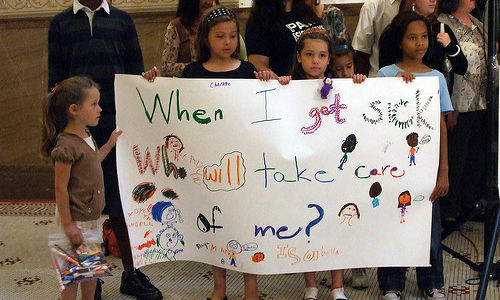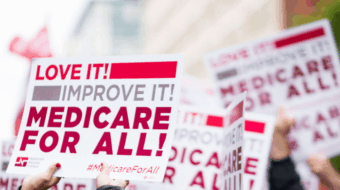
The return of the swine flu, this time with a vengeance, has officials bracing for a flu season much worse than the normal ones when 5 percent to 20 percent of the population gets sick, with some ending up in hospitals and others even dying.
Last week’s declaration of a national emergency by the president, after a panel he appointed projected that the H1N1 virus could infect half the U.S. population this fall and winter, has resulted in a new push by labor and its allies for guaranteed sick days.
At a rally backing a paid sick days measure in New York City, Mike Fishman, president of 32BJ Service Employees International Union (SEIU), said, “When union doormen get sick, they can take off because they have sick days. But if you are a security officer in the city you are going to be at work if you are sick, because you cannot afford to take the day off without pay.”
Unions see the fight for paid sick days as integral to any national strategy to protect public health during the swine flu epidemic.
Federal statistics show that almost 40 percent of all flu cases are transmitted in schools and workplaces. The Centers for Disease Control says sick workers should stay home and remain there for 24 hours after their fever subsides.
Unions are quick to point out, however, that the CDC recommendation is impossible to carry out because half of all workers in the nation are not able to take even one paid sick day when ill. Only a third of all workers who have sick children are able to take a paid day.
“I see it all the time,” an emergency room nurse at Cook County Hospital in Illinois said. “Mothers and fathers are worried to death when they come here, not just about the fever their child has but about how much pay they are going to lose and whether they might lose their job altogether because they have to take care of that child.”
Last May President Obama said, in one of his weekly radio talks, “We urge employers to allow infected employees to take as many paid sick days as necessary.”
Unions believe that with the lack of state and federal standards mandating paid sick days, the president’s good intentions will not go far enough to solve the problem. They are coming forward with solutions on various levels.
Cincinnati Federation of Teachers Local 1520 recently won a contract that allows members to take sick time for exposure to contagious disease and use five days of sick time in advance in any given pay period.
Unions say, however, that regulatory changes are needed.
Such changes in regulations were proposed recently to protect federal workers from the spread of communicable diseases by expanding sick leave.
Under the proposed changes, federal workers could use sick time to care for themselves or a family member due to exposure to a communicable disease, whether or not they display symptoms.
Federal employees would also be able to use in advance up to 30 days of sick time due to their own exposure, or 13 days for a family member’s exposure.
The proposed policy is the type of policy unions all over the country will begin bargaining for, say officials at the AFL-CIO.
San Francisco guarantees paid sick days for its workers, and unions, like SEIU in New York, are joining with community allies to fight for similar policies elsewhere.
The Labor Project for Working Families has set up a web site to help unions get involved in local campaigns for paid sick days, at www.working-families.org.
Photo: http://www.flickr.com/photos/vocesdelafrontera/ / CC BY 2.0










